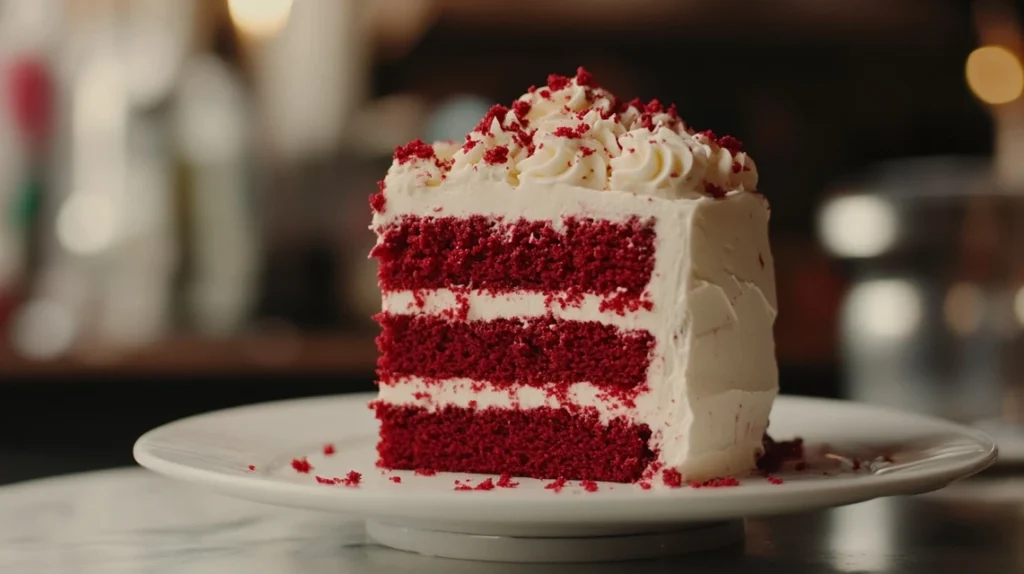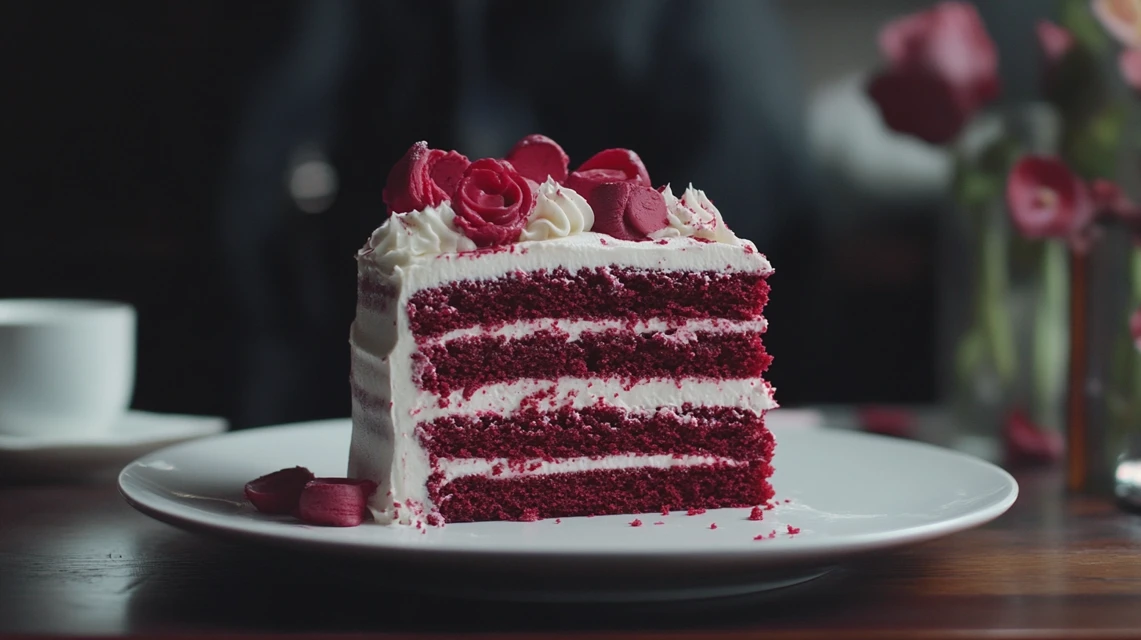Introduction
Red velvet cake is a uniquely beautiful and delicious dessert that has captured the hearts (and taste buds) of many. With its vibrant color, smooth texture, and distinctive cream cheese frosting, it’s not just a treat but an experience. While many adore it, few know the fascinating story behind this dessert or why it stands out among cakes. Let’s explore the origins, ingredients, and why it holds a special place in the world of baking.
Origins and History of Red Velvet Cake
The history of red velvet cake is rich and spans nearly a century. Early forms of “velvet cakes” appeared in the Victorian era, prized for their soft, delicate crumb, created by adding cocoa powder to the batter. This technique gave rise to cakes that were smoother and finer than others, ultimately leading to the famous red velvet we know today.

By the 1930s, the Waldorf Astoria Hotel in New York City helped popularize red velvet cake, putting it on the map as an iconic dessert. Interestingly, early versions of the cake achieved their hue naturally, thanks to the chemical reaction between acidic ingredients and cocoa powder. For an in-depth look at how red velvet achieved its status, check out the history behind red velvet.
Beetroot and Food Coloring
During World War II, when food rationing made food coloring scarce, beetroot juice was used to enhance the cake’s natural red color. Today, however, most red velvet cakes use food coloring for that striking red hue. The cake’s color remains symbolic, adding a visual allure that makes it perfect for celebrations and themed events.
For more insight on adding natural or alternative colors to cakes, consider reviewing how to make cakes without artificial dyes, which explores creative ingredient substitutions.
What Makes Red Velvet Cake Unique?

Beyond its color, red velvet cake has a texture and flavor that’s distinct and indulgent.
- Texture: The cake’s texture is smooth and moist, created through a mix of buttermilk, vinegar, and baking soda, which result in a tight, tender crumb.
- Flavor: Often mistaken for chocolate cake, red velvet is only mildly chocolatey and is balanced with a slight tang, courtesy of the buttermilk and vinegar.
- Cream Cheese Frosting: This frosting pairs perfectly with the cake’s tangy undertone, adding richness and balance.
For a comparison on how frosting types can transform the experience of a dessert, check out the guide on best frosting combinations for cakes.
Key Ingredients That Define Red Velvet Cake

The signature flavor and texture of red velvet cake are achieved through specific ingredients that work together harmoniously.
- Buttermilk and Vinegar: These add the slight tang and contribute to the cake’s moisture and crumb.
- Cocoa Powder: While minimal, the cocoa powder provides a subtle chocolate base, enhanced by the cake’s acidic ingredients.
- Red Food Coloring: While natural coloring options exist, most modern recipes use artificial red food coloring for a more vibrant color.
Many bakers now opt for natural alternatives to food coloring, like beet juice, for a more organic approach. You can learn more about natural ingredient substitutions in this natural baking guide.
Cultural Significance and Popularity of Red Velvet Cake

Southern Heritage
Red velvet cake has roots in Southern cuisine, where it’s celebrated as a staple dessert for holidays, weddings, and other special events. Its association with Southern charm has made it a symbol of comfort, indulgence, and celebration, loved by people far and wide.
What is the Big Deal About Red Velvet Cake?
Introduction
Red velvet cake is known for its striking red color and creamy, smooth texture. It’s not just a treat; it’s an experience. Many love it, but few know its rich backstory. Let’s explore what makes red velvet stand out and why it remains so popular.
Origins and History of Red Velvet Cake
The story of red velvet cake began over a century ago. Early “velvet cakes” were popular in the Victorian era for their soft, fine crumb. In the 1930s, the Waldorf Astoria Hotel introduced red velvet as a star dessert. The natural red hue in these cakes came from cocoa reacting with acidic ingredients.
During World War II, beetroot juice was used to enhance the red color when food coloring was scarce. Today, food coloring helps achieve that eye-catching red we associate with the cake. You can learn more about the history of red velvet in detail.
What Makes Red Velvet Cake Unique?
Red velvet is not just about the color. It has a unique flavor and texture as well.
- Texture: The combination of buttermilk, vinegar, and baking soda gives a smooth, tender crumb.
- Flavor: The cake has a mild cocoa base with a slight tang.
- Frosting: The cream cheese frosting adds richness and balances the cake’s taste.
This texture and taste set red velvet apart from regular chocolate cake.
Key Ingredients That Define Red Velvet Cake
A few ingredients define red velvet cake and give it its distinct qualities.
- Buttermilk and Vinegar: These add moisture and a tangy flavor.
- Cocoa Powder: The base for the cake’s mild chocolate flavor.
- Red Food Coloring: Modern recipes use it for a bold color.
Some prefer natural color from ingredients like beet juice.
Cultural Significance of Red Velvet Cake
Southern Heritage
The cake has deep roots in Southern cuisine. It’s a popular choice for celebrations, holidays, and weddings.
Pop Culture and Trends
Red velvet cake often appears in movies, themed weddings, and events. Its unique look and flavor make it a favorite worldwide.
FAQs
- Is red velvet cake just chocolate cake with food coloring?
No. While it contains cocoa, the recipe is unique. - Why is red velvet cake so popular?
Its color, texture, and nostalgic appeal make it a favorite. - What gives red velvet cake its red color?
Originally, the color came from cocoa and acid reactions. Now, food coloring is used.
Conclusion
Red velvet cake is more than a dessert. It’s a special experience with a fascinating history, a unique taste, and a look that’s perfect for any celebration.
Additional Internal Linking Opportunities
- Is Red Velvet Cheesecake a Good Dessert Choice? – A perfect pairing option for dessert enthusiasts looking to explore unique twists on classic red velvet.
- What’s the Flavor Profile of Red Velvet? – A deep dive into red velvet’s unique taste and texture that contrasts with other cakes.
- Best Frosting Options for Cakes – Alternative frostings that enhance the flavor of red velvet cake beyond traditional cream cheese frosting.
Each link provides further insights into making the red velvet experience even richer, adding value for readers exploring various aspects of this beloved cake.

